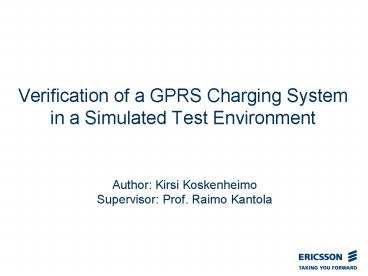Verification of a GPRS Charging System in a Simulated Test Environment - PowerPoint PPT Presentation
Title:
Verification of a GPRS Charging System in a Simulated Test Environment
Description:
Title: Verification of a GPRS Charging System in a Simulated Test Environment Description: Rev PA1 Last modified by: raija Created Date: 10/26/2004 9:20:03 PM – PowerPoint PPT presentation
Number of Views:61
Avg rating:3.0/5.0
Title: Verification of a GPRS Charging System in a Simulated Test Environment
1
Verification of a GPRS Charging System in a
Simulated Test Environment
- Author Kirsi Koskenheimo
- Supervisor Prof. Raimo Kantola
2
Contents
- Background and Goals
- Flexible Charging in GGSN
- Simulated Test Environment
- Simulations and Results
- Conclusions
- Further Development
3
Background and Goals
- Problem
- GGSN (Gateway GPRS Support Node) support starting
at Finland - Lack of knowledge about node, simulators and
charging - How to solve it
- Familiarize with GGSN, simulators and flexible
charging - Setting up a test network
- GGSN
- Outline (charging node simulator)
- Trembler (SGSN MS/UE simulator)
- Sgsnemu (SGSN emulator)
- Dummynet (delay, queue and bandwidth limitation
simulator) - Ethereal (network protocol analyzer)
- Investigate the suitability of simulated test
environment to testing of flexible charging - What is possible to test with simulators in test
environment?
4
Flexible Charging in GGSN
- Until now, PS charging often based on flat rate
(monthly fee) - Flat rate pricing not enough especially on QoS
network - Traditional charging volume and byte based
- 3GPP specification of Flow Based Charging (FBC)
- Possibility to separately charge services that
use the same bearer - Identification of charging data
- Based on QoS
- Based on traffic destination
- Charging rules
- Separate rules based on Access Point Name (APN)
- Separate rules for UL and DL
- Separate rules for users
5
Different Browsing Areas
6
Flexible Charging in GGSN
- Ericsson solution Service Aware Charging
Control (SACC) - Enables charging based on different price levels
- Pre- and Postpaid Charging
- Byte- and Block-Based Charging
- Time- and Volume-Based Charging (kuva)
7
Simulated Test Environment
8
Simulations and Results
- Determination of Test Cases
- Cover a wide range of GGSN charging
- Focus on prepaid users
- Tested functionalities
- Traffic filtering
- Identification of Prepaid users
- Charging at different time of day (ToD)
- Service authorization (roaming, time)
- Byte- and Block-Based charging
- Time- and Volume-Based charging
9
Simulations and Results
- Problems faced
- Lack of components
- (Not possible to generate all situations that
exist in real life) - Not possible to filter traffic
- Some exact messages
- Not possible to perform with used simulators
- Charging Data Records (CDR)
- No stable system
10
Simulations and Results
- Results
- Simulated test environment is applicable to the
testing of SACC charging - Basic SACC functions were tested successfully
with simulators. - Traffic was filtered correctly
- Prepaid users were identified correctly
- Rating was dependent of ToD
- Services could be authorized successfully
- Services could be charged correctly based on time
or volume - Services could be charged correctly based on byte
or block - Basic functionalities can be more easily
performed with simulators than with real charging
nodes - More complex testing can also be executed but it
requires more knowledge of charging and coding.
11
Conclusions
- A diverse test environment was set up, although
all testing possibilities were not used. - Knowledge of the SACC solution, the simulators
and GGSN configuration was obtained - The features that can be tested in the simulated
test environment were found and tested. - The created test environment enables more
versatile testing than what was performed in this
thesis.
12
Further Development
- More specific testing
- Specific message creation
- In hexadecimal format
- Different rates for specific days (e.g. weekends)
- In hexadecimal format
- Use of other PCs and simulators
- Sgsnemu
- Traffic generation
- Dummynet
- Propagation delays
13
Thank You
- Comments?
- Questions?
14
(No Transcript)
15
Additional Slides
16
3GPP Specification vs. Ericsson Solution
17
Time-Based Block Charging
Inactivity time period 3 blocks (B) User is
charged in B1, B2, B3, B4, B9 User will not be
charged for B5, B6, B7, B8 (time between the 2nd
and the 3rd charging event is larger than 3B)
18
Volume-Based Block Charging

